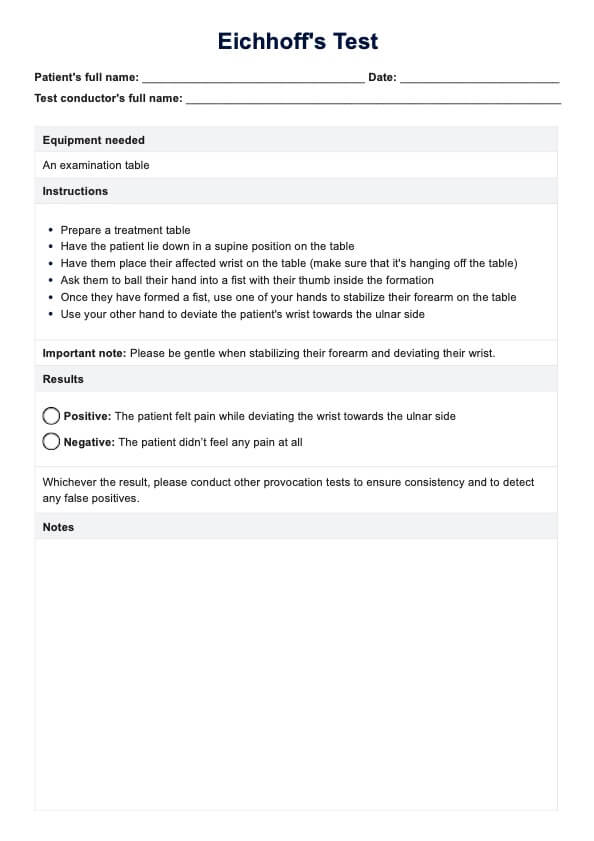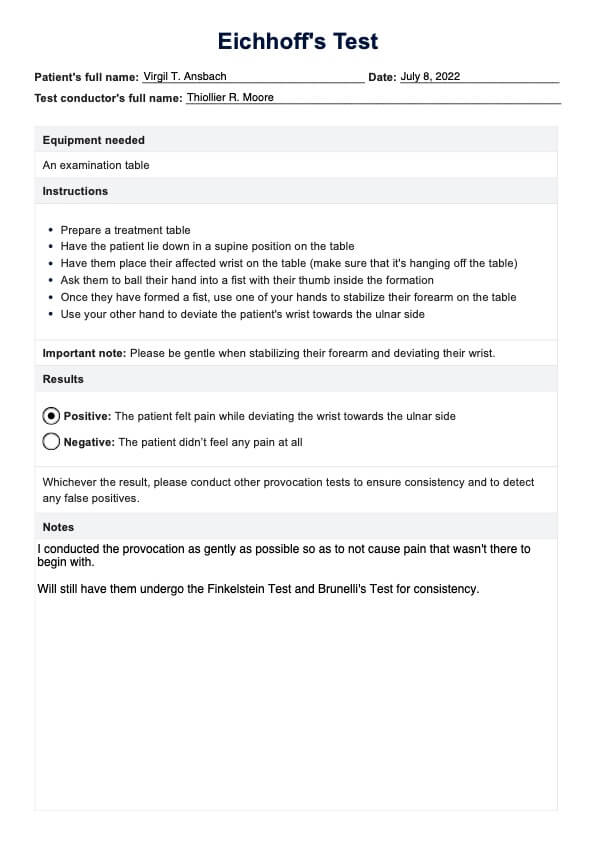Eichhoff's Test
Perform the Eichhoff's Test to detect the possibility of De Quervain's tenosynovitis in patients.


What is De Quervain's tenosynovitis?
De Quervain's tenosynovitis (sometimes called De Quervain's syndrome or disease) is a tendon-related condition that affects the thumb area of the wrist. It is characterized by pain in that location whenever the person turns their wrist, balls their hands into a fist, or attempts to grip an object. Patients with this condition might also have swelling at the base of their thumbs.
Engaging in any activity that requires repetitive hand and wrist movements (and there are many of these, including work and activities of daily living) will worsen this condition. When it worsens, the person with De Quervain's tenosynovitis will feel the pain radiate throughout the thumb and even the forearm.
How to diagnose De Quervain's disease
To diagnose De Quervain tenosynovitis, healthcare professionals must conduct several tests, from provocation to imaging tests, to reduce the risk of false positives.
The provocation tests (such as Finkelstein's test and Brunelli's test) are conducted to check for the possibility of the patient having it. These tests look for specific signs, and if those specific signs show themselves, that means a positive test result for each of them. Conducting several is recommended to narrow down the problem and increase the likelihood of the condition.
After the provocation tests, an imaging test will confirm the diagnosis of De Quervain's tenosynovitis or any other potential disease or problem causing pain, like osteoarthritis.
While the Finkelstein Test is used most in clinical practice to detect the condition, you can conduct the Eicchoff's Test to do the same!
Eichhoff's Test Template
Eichhoff's Test Example
What is the Eichoff's Test?
Eichhoff's Test is another type of provocation test for detecting De Quervain's tenosynovitis, but it isn't as widely used as the Finkelstein Test because it is possible to produce a false positive result using it if not done correctly and carefully. The reason why is that if not done correctly, it can cause pain. Since provocation tests tend to use pain as a positive sign for the possibility of the problem, this can lead to a false positive result if there is no pain in the thumb area of the wrist in the first place. Given this, it's recommended to conduct this test before resorting to other provocation tests. Remember that covering all bases is best.
How to perform the Eichhoff's Test?
Provocation tests are quite easy to perform in general. To perform the Eichhoff's Test, you only need to do the following:
- Prepare a treatment table
- Have the patient lie down in a supine position on the table
- Have them place their affected wrist on the table (make sure that it's hanging off the table)
- Ask them to ball their hand into a fist with their thumb inside the formation
- Once they have formed a fist, use one of your hands to stabilize their forearm on the table
- Use your other hand to deviate the patient's wrist towards the ulnar side
These are all the steps you need to do to perform Eichhoff's Test! Easy, right? Just remember to be gentle.
Results and interpretations of Eichhoff's Test
Now, what exactly are we looking for when conducting this test? What we're trying to elicit here is pain, specifically in the area of the extensor pollicis brevis and and abductor pollicis longus. If they feel pain in that area of the thumb, the Eichhoff's Test is positive. If not, then it's negative.
Remember what we said about being gentle? The reason is that Eichhoff's Test has the chance to produce false positives. You want to elicit pain that's already there, not cause it when it didn't exist in that area of the thumb.
We recommend conducting other provocation tests after this, like the Finkelstein Test so you can have more consistency with positive results, or to confirm if the Eichhoff maneuver produced a false positive result.
Benefits of using our template
More often than not, provocation tests don't come with test result sheets, so by using our template, you can easily make a record of test results and note down other plans for the diagnosis of De Quervain's disease. This makes it easier for you and your team to track what has been done during the diagnostic process. Passing around information between team members handling a certain patient becomes easier.
It can even be used during monitoring sessions to see if the patient is getting any better, but again, it would be best to reconduct other provocation tests alongside this to produce consistent results and observations.
Treatment of De Quervain's Tenosynovitis
Conservative treatment
Before resorting to anything drastic, it's always best to begin with the most conservative types of treatment. Simply resting (avoiding activities that involve repetitive wrist movements) could help. Icing the wrist might do so as well to relieve the pain and prevent any swelling from getting any larger.
If those are not enough, then wearing a brace for your wrist to prevent it from moving, or taking nonsteroidal anti-inflammatory drugs might do the trick. Eventually, the patient will have to exercise their wrist to regain and improve its strength. So having them do certain wrist exercises for a set amount of time will restore the wrist back to its former state.
Invasive treatment: corticosteroids and hand surgery
If conservative methods don't work, injecting the affected area with corticosteroids might help reduce the symptoms of De Quervain's disease. If all other treatments don't do it for the patient, then the last resort is hand surgery, specifically the one meant for De Quervain's disease. This involves a surgeon cutting the fibrous roof of the thumb's tunnel causing the problem. By cutting open this part, the tendons in that area have more room to move.
Commonly asked questions
Because this test has the chance of producing false positives if not done correctly and gently. Instead of eliciting pain that's already there, you might cause pain.
You can still conduct it, but it would be best to conduct it as the first provocation test of several. Other tests can help determine if there was a false positive or produce consistent positive results.
It can be done in 5 minutes.







































































































